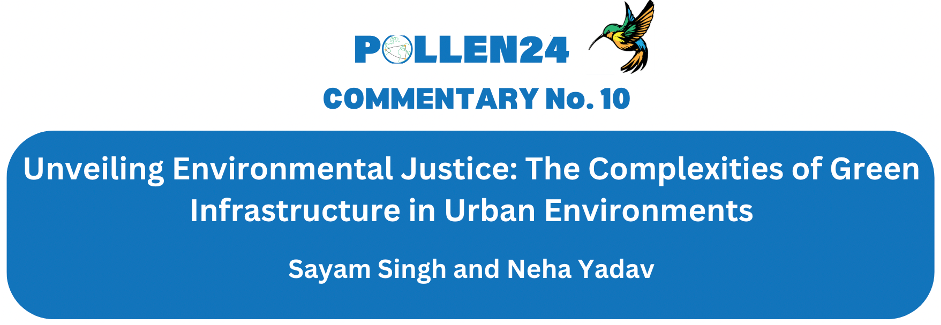2024-05-09
Unveiling Environmental Justice: The Complexities of Green Infrastructure in Urban Environments

Abstract
In this essay, we will delve into the injustices within urban environments, exploring how environmental justice principles can illuminate and address these pressing issues. Through an examination of the interconnected factors contributing to environmental injustices in urban settings, we will highlight the importance of adopting a holistic approach to tackle these challenges effectively. By analysing case studies and drawing on scholarly research, we will elucidate the critical role of environmental justice in promoting equity, sustainability, and resilience in urban landscapes.
Introduction
The field of environmental justice has evolved significantly from its origins, initially targeting racial disparities in environmental hazards, to encompassing a broader range of injustices affecting marginalized communities, including the poor, indigenous groups, and people of colour (Sze and London, 2008; Wilson, 2010). This evolution reflects its transformation into a comprehensive framework for confronting discrimination in spatial planning, combating unfavourable environmental conditions, and addressing health disparities resulting from environmental factors (Sze and London, 2008; Wilson, 2010).
In this essay, we will delve into the injustices within urban environments, exploring how environmental justice principles can illuminate and address these pressing issues. Through an examination of the interconnected factors contributing to environmental injustices in urban settings, we will highlight the importance of adopting a holistic approach to tackle these challenges effectively. By analysing case studies and drawing on scholarly research, we will elucidate the critical role of environmental justice in promoting equity, sustainability, and resilience in urban landscapes.
Green Infrastructure and Environmental Injustice
As the impacts of anthropogenic climate change become increasingly apparent, the integration of green infrastructure within urban environments has emerged as a crucial strategy for mitigation. While this approach has shown promise in addressing environmental concerns, it also unveils complex issues of environmental justice and socio-economic inequality (Zuniga-Teran et al., 2019). In this section, we will explore how green measures have been accompanied by inequalities. We’ll first present the example of Curitiba and then shed light on other areas to emphasise upon the significance of the problem.
Environmental inequalities have accompanied rapid urbanisation in Latin America (Fernández et al., 2023). With its extensive public transport network, strategically designated park land, focus on environment sustainability and social inclusion, Curitiba, Brazil is an example of a city within the developing world that successfully implemented its plan for sustainable urban development in the Global South (Gustafsson & Kelly, 2012).
It was chosen as a case study due to its reputation as a pioneer in sustainable urban development, offering valuable insights into the complexities of integrating green infrastructure within rapidly growing urban environments. Its innovative approaches and challenges reflect broader issues of environmental justice and socio-economic inequality, making it a compelling example for understanding the implications of green infrastructure on marginalized communities. Additionally, Curitiba's experiences provide valuable lessons and strategies for addressing environmental injustices in other urban contexts globally.
Curitiba invested in an extensive park system, strategically protecting low-lying areas, river basins, and protective zones along watercourses, effectively reducing flood risk, (Gustafsson and Kelly, 2022). Curitiba, with its 35 parks, 1,004 conservation areas, and 78,000 square meters of natural forest, boasted a remarkable 64 square meters of green space per resident (Gustafsson & Kelly, 2012). Green spaces and parks represent about a fifth of the city’s urban space (Gustafsson & Kelly, 2016).
incorporation of public parks was accompanied by the problem of green gentrification. Analysis of green space distribution within Curitiba revealed a stark contrast, with the vast majority of green spaces concentrated in the northern and southwestern regions of the city, primarily in affluent neighbourhoods, while poorer neighbourhoods in the southwestern region, characterized by irregular occupations encroaching on protected areas surrounding Curitiba, lacked adequate green spaces. (Giacomini et al., 2016). In Curitiba, strong economic segregation is closely intertwined with racial segregation, as neighbourhoods inhabited by the poorest individuals often coincide with areas predominantly inhabited by African-origin residents (Wójtowicz, 2014).
Thus, incorporation of green spaces within cities exacerbated existing inequalities. Green gentrification is not a problem for Curitiba alone. Its impact is felt by different communities across the globe. Research in the US contends that urban greening, particularly through green gentrification, can exacerbate racial environmental injustices, leading to compounded environmental racisms by worsening disparities and perpetuating racialized displacement, re-segregation, and exclusion within communities (Lewartowska et al., 2024). Urban greening served to cement misbalanced colonial power relations, at great cost to indigenous communities (Porter et al., 2020).
Addressing Environmental Injustice
We propose a dual approach for achieving environmental justice. Firstly, green infrastructure should extend beyond traditional parks, integrating directly into urban structures to foster sustainable living environments. We propose that integrating indigenous knowledge and traditional architecture is a valuable strategy to ensure sustainable and inclusive development. Secondly, community engagement is vital to ensure that green initiatives are inclusive, responsive to local needs, and promote equitable access to environmental benefits. Emphasizing community dialogue and social cohesion is crucial for addressing gentrification challenges and promoting equity within communities (Bernstein and Isaac, 2023). Thus, stakeholder engagement, incorporating concerns of race and indigenous methods, is essential for promoting holistic and just sustainability.
The scope of green infrastructure must be widened beyond parks to encompass a carefully orchestrated system of natural and semi-natural spaces integrated into urban areas (Nieuwenhuijsen, 2023). Thus, instead of creating green spaces, spaces must turn green with architecture being at the helm of sustainability. Combining traditional materials with modern technology in green buildings in Sub-Saharan Africa maintained inner thermal comfort effectively (Ejiga et al., 2012). Thus, local knowledge is crucial in sustainable architecture. This can be useful for Brazil too where heat inequity is a perpetual problem (Jung et al., 2023). In addition to maintaining temperature, adapting indigenous methods to construction of modern buildings reduced energy consumption (Ramezani and Raza, 2022).
Thus, by blending tradition with modern techniques, architects can create contextually rooted structures while minimizing ecological impact, prioritizing community involvement and sustainable development. Adaptation of principles of indigenous architecture in contemporary buildings in North America and collaborative efforts in Indonesia serve as compelling examples of this approach (Mashford-Pringle et al., 2023; Yuliani & Setyaningsih, 2023).
Conclusion
The integration of green infrastructure in cities holds promise for addressing environmental concerns but also exposes socio-economic disparities. To foster equitable urban landscapes, a holistic approach is needed, integrating local knowledge into sustainable architecture and prioritizing community involvement. Future research should explore initiatives like the green-blue initiative and examine inequalities in access to resources like water to inform more inclusive urban policies.
Notes
[1] London School of Economics
[2] Jawaharlal Nehru University
References
Bernstein, A. G., & Isaac, C. A. (2023). Gentrification: The role of dialogue in community engagement and social cohesion. Journal of Urban Affairs, 45(4), 753–770. https://doi.org/10.1080/07352166.2021.1877550
Ejiga, O., Paul, O., & Cordelia, O. O. (2012). Sustainability in traditional African architecture: a springboard for sustainable urban cities. Sustainable Futures: Architecture and Urbanism in the Global South Kampala, Uganda. [Online]. Available: http://sfc2012.org/opaluwa_obi_osasona.pdf
Fernández, I. C., Koplow-Villavicencio, T., & Montoya-Tangarife, C. (2023). Urban Environmental Inequalities in Latin America: A scoping review. World Development Sustainability, 2, 100055. https://doi.org/10.1016/j.wds.2023.100055
Giacomini Martínez, J., Boas, I., Lenhart, J., & Mol, A. P. J. (2016). Revealing Curitiba's flawed sustainability: How discourse can prevent institutional change. Habitat International, 53, 350-359. DOI: 10.1016/j.habitatint.2015.12.007
Gustafsson , H.-R., & Kelly, E. (2012). URBAN INNOVATIONS IN CURITIBA: A CASE STUDY. Eugene & Carol Ludwig Center for Community and Economic Development. [Online]. Available: https://www.urban-response.org/system/files/content/resource/files/main/mercy-corps-urban-programming.pdf
Gustafsson, H.-R., & Kelly, E. A. (2022, December 30). “developing the sustainable city: Curitiba, Brazil, as a case study”. Taylor & Francis. [Online]. Available: https://www.taylorfrancis.com/chapters/edit/10.4324/9781003288718-77/developing-sustainable-city-curitiba-brazil-case-study-hanna-ruth-gustafsson-elizabeth-kelly
Jung, M. W., Haddad, M. A., & Gelder, B. K. (2024). Examining heat inequity in a Brazilian metropolitan region. Environment and Planning B: Urban Analytics and City Science, 51(1), 109-127. DOI: 10.1177/23998083231170634
Lewartowska, E., Anguelovski, I., Oscilowicz, E., Triguero‐Mas, M., Cole, H., Shokry, G., Pérez‐del‐Pulgar, C., & Connolly, J. J. (2024). racial inequity in green infrastructure and gentrification: Challenging compounded environmental Racisms in the green city. International Journal of Urban and Regional Research, 48(2), 294–322. DOI: 10.1111/1468-2427.13232
Mashford-Pringle, A., Fu, R., & Stutz, S. (2023). Mamwi Gidaanjitoomin/Together We Build It: A Systematic Review of Traditional Indigenous Building Structures in North America and Their Potential Application in Contemporary Designs to Promote Environment and Well-Being. International journal of environmental research and public health, 20(6), 4761. https://doi.org/10.3390/ijerph20064761
Nieuwenhuijsen, M. J. (2023). Green Infrastructure and Health. Annual Review of Public Health, 42, 317–328.
Porter, L., Hurst, J., & Grandinetti, T. (2020). The politics of greening unceded lands in the settler city. Australian Geographer, 51(2), 221–238. DOI: 10.1080/00049182.2020.1740388
Ramezani H, Reza E. The Consequence of Combining Indigenous Techniques with a Flexible Design to Reduce Energy Consumption in Residential Buildings for Future Architecture. Sustainability. 2022; 14(21):13958. https://doi.org/10.3390/su142113958
Sze, J., & London, J. K. (2008). Environmental justice at the Crossroads. Sociology Compass, 2(4), 1331–1354. DOI: 10.1111/j.1751-9020.2008.00131.x
Wilson, S. M. (2010). Environmental Justice Movement: A Review of History, Research, and Public Health Issues. Journal of Public Management & Social Policy, 16(1). [Online]. Available: https://doi.org/https://openurl.ebsco.com/EPDB%3Agcd%3A16%3A27488336/detailv2?sid=ebsco%3Aplink%3Ascholar&id=ebsco%3Agcd%3A51444641&crl=c
Wójtowicz, M., & Winiarczyk-Raźniak, A. (Eds.). (2014). Racial and economic segregation in Curitiba. In Environmental and Socio-economic Transformations in Developing Areas as the Effect of Globalization (pp. 34–48). Kraków: Wydawnictwo Naukowe UP.
Yuliani, S., & Setyaningsih, W. (2023). Green architecture in tourism sustainable development a case study at Laweyan, Indonesia. Journal of Asian Architecture and Building Engineering, 1–12. https://doi.org/10.1080/13467581.2023.2287198
Zuniga-Teran, A. A., Staddon, C., de Vito, L., Gerlak, A. K., Ward, S., Schoeman, Y., … Booth, G. (2020). Challenges of mainstreaming green infrastructure in built environment professions. Journal of Environmental Planning and Management, 63(4), 710–732. https://doi.org/10.1080/09640568.2019.1605890
